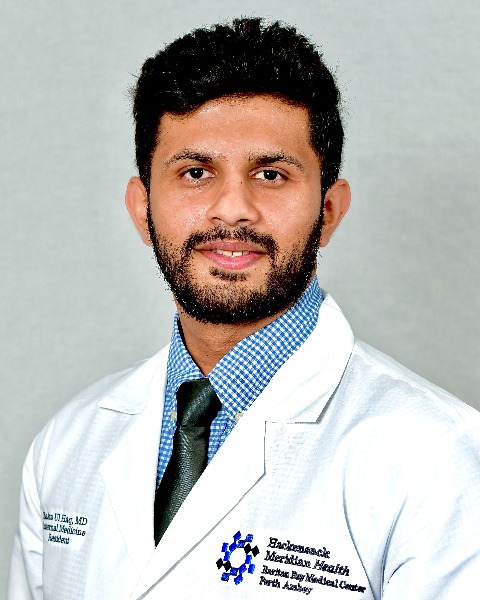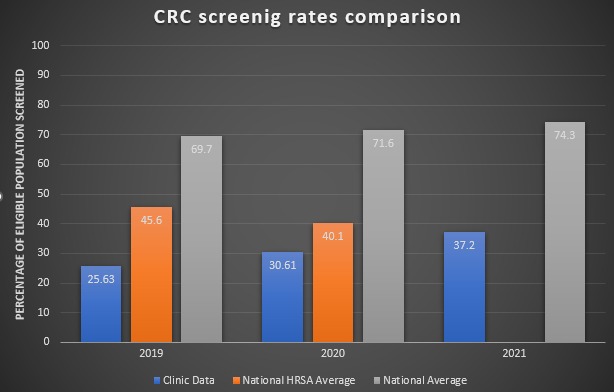Back


Poster Session A - Sunday Afternoon
Category: Colorectal Cancer Prevention
A0180 - Colorectal Cancer Screening Rate Comparison in an Underserved Population With National Average and Interventions to Improve the Quality Care in a Resident-Led Clinic
Sunday, October 23, 2022
5:00 PM – 7:00 PM ET
Location: Crown Ballroom

Has Audio

Zaka Ul Haq, MD
Raritan Bay Medical Center
Edison, NJ
Presenting Author(s)
Zaka Ul Haq, MD1, Abdallah Khashan, MD1, Samer Talib, MD1, Hamidul Islam, 2, Robert Aaron, MD3, Cynthia L. Vuittonet, MD2
1Raritan Bay Medical Center, Perth Amboy, NJ; 2Jewish Renaissance Medical Center, Perth Amboy, NJ; 3Allied Digestive Health, Freehold, NJ
Introduction: Late diagnosis of colorectal cancer is linked to higher mortality. Early diagnosis can be achieved through proper screening of the eligible population. Patients served at Federally Qualified Health Centers (FQHC) have CRC screening rates disproportionately lower than the national average. According to the HRSA in 2020, 40.1% of eligible adults were up to date with CRC screening compared to CDC data which shows in 2018, 68.8% of qualified individuals were current with CRC screening. This project highlights a three-year quality improvement initiative to increase screening rates in an underserved FQHC resident-led clinic.
Methods: A retrospective single-center quality improvement study was done to determine rates of CRC screening between 2019 to 2021. As illustrated in the figure below, changes were implemented at different intervals, such as identifying the barriers to care, proper utilization of EMR, provider education, and Fecal Immunochemical Test (FIT) kit availability in the provider room.
Results: Serial interventions were done to improve the screening rates of the population receiving CRC screening. From 2019 to 2020, this project focused on proper utilization within the EMR, and screening rates increased from 25.63% to 30.61%, a 4.98% increase in screening percentage. From 2020 to 2021, this project focused on provider EMR utilization, availability of FIT kits in every exam room, and education geared towards patient compliance, which resulted in a 6.59% increased screening rate with a total rate of 37.20% Overall, there was 17% improvement in CRC screening rates.
Discussion: CRC screening rates are widely different depending on the area, insurance coverage, and education level of the patients. In underserved areas, there is a lower screening prevalence compared to the national average. In our study, we compared the screening prevalence in an underserved area in Perth Amboy with the national average. Our study showed that the screening rate of the eligible population for CRC screening was 25.63% in 2019, compared with the national average of 69.7% in the same year. We took steps forward to enhance CRC screening in our population by educating the clinicians and increasing FIT kit availability in exam rooms. Data showed an increase in the prevalence from 25.63% in 2019 to 37.20% in 2021 after applying these interventions. The purpose of this study is to increase the screening rates to match the national average, which will decrease mortality from CRC and will improve quality care.

Disclosures:
Zaka Ul Haq, MD1, Abdallah Khashan, MD1, Samer Talib, MD1, Hamidul Islam, 2, Robert Aaron, MD3, Cynthia L. Vuittonet, MD2. A0180 - Colorectal Cancer Screening Rate Comparison in an Underserved Population With National Average and Interventions to Improve the Quality Care in a Resident-Led Clinic, ACG 2022 Annual Scientific Meeting Abstracts. Charlotte, NC: American College of Gastroenterology.
1Raritan Bay Medical Center, Perth Amboy, NJ; 2Jewish Renaissance Medical Center, Perth Amboy, NJ; 3Allied Digestive Health, Freehold, NJ
Introduction: Late diagnosis of colorectal cancer is linked to higher mortality. Early diagnosis can be achieved through proper screening of the eligible population. Patients served at Federally Qualified Health Centers (FQHC) have CRC screening rates disproportionately lower than the national average. According to the HRSA in 2020, 40.1% of eligible adults were up to date with CRC screening compared to CDC data which shows in 2018, 68.8% of qualified individuals were current with CRC screening. This project highlights a three-year quality improvement initiative to increase screening rates in an underserved FQHC resident-led clinic.
Methods: A retrospective single-center quality improvement study was done to determine rates of CRC screening between 2019 to 2021. As illustrated in the figure below, changes were implemented at different intervals, such as identifying the barriers to care, proper utilization of EMR, provider education, and Fecal Immunochemical Test (FIT) kit availability in the provider room.
Results: Serial interventions were done to improve the screening rates of the population receiving CRC screening. From 2019 to 2020, this project focused on proper utilization within the EMR, and screening rates increased from 25.63% to 30.61%, a 4.98% increase in screening percentage. From 2020 to 2021, this project focused on provider EMR utilization, availability of FIT kits in every exam room, and education geared towards patient compliance, which resulted in a 6.59% increased screening rate with a total rate of 37.20% Overall, there was 17% improvement in CRC screening rates.
Discussion: CRC screening rates are widely different depending on the area, insurance coverage, and education level of the patients. In underserved areas, there is a lower screening prevalence compared to the national average. In our study, we compared the screening prevalence in an underserved area in Perth Amboy with the national average. Our study showed that the screening rate of the eligible population for CRC screening was 25.63% in 2019, compared with the national average of 69.7% in the same year. We took steps forward to enhance CRC screening in our population by educating the clinicians and increasing FIT kit availability in exam rooms. Data showed an increase in the prevalence from 25.63% in 2019 to 37.20% in 2021 after applying these interventions. The purpose of this study is to increase the screening rates to match the national average, which will decrease mortality from CRC and will improve quality care.

Figure: CRC Screening Rates Comparison
Disclosures:
Zaka Ul Haq indicated no relevant financial relationships.
Abdallah Khashan indicated no relevant financial relationships.
Samer Talib indicated no relevant financial relationships.
Hamidul Islam indicated no relevant financial relationships.
Robert Aaron indicated no relevant financial relationships.
Cynthia Vuittonet indicated no relevant financial relationships.
Zaka Ul Haq, MD1, Abdallah Khashan, MD1, Samer Talib, MD1, Hamidul Islam, 2, Robert Aaron, MD3, Cynthia L. Vuittonet, MD2. A0180 - Colorectal Cancer Screening Rate Comparison in an Underserved Population With National Average and Interventions to Improve the Quality Care in a Resident-Led Clinic, ACG 2022 Annual Scientific Meeting Abstracts. Charlotte, NC: American College of Gastroenterology.
